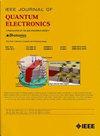软孔径空间滤波:1.5W单空间模式从高多模激光二极管在一个外腔
IF 2.2
3区 工程技术
Q3 ENGINEERING, ELECTRICAL & ELECTRONIC
引用次数: 0
摘要
广域激光二极管因其能产生高光功率而具有吸引力。不幸的是,这种高功率通常是以严重降低空间相干性为代价的,因为二极管波导的广域本质上是沿慢轴的空间多模。我们展示了一种通过将高功率广域二极管放置在模式选择的外腔中来显着提高其空间相干性的方法。我们设计的腔,使二极管孔径作为其自身的空间滤波器,避免了腔内狭缝滤波器的需要,并最佳地利用整个增益介质。我们使用宽度为$200 \rm {\mu m}$和$300 \rm {\mu m}$的宽二极管演示了这种软滤波方法,并将其功率效率与带狭缝的标准硬滤波方法进行了比较。我们在纯单模下获得了高增益操作,在1064 nm处展示了高达1.5 W的连续波功率,具有出色的光束质量(90%功率时$M^{2}=1.3$)。本文章由计算机程序翻译,如有差异,请以英文原文为准。
Soft Aperture Spatial Filtering: 1.5W in a Single Spatial Mode From a Highly Multi-Mode Laser Diode in an External Cavity
Broad area laser diodes are attractive for the high optical power they can produce. Unfortunately, this high power normally comes at the cost of severely reduced spatial coherence since the wide area of the diode wave-guide is inherently spatially multi-mode along the slow axis. We demonstrate a method to significantly improve the spatial coherence of a high-power broad-area diode by placing it in an external cavity that is mode selective. We design the cavity, such that the diode aperture acts as its own spatial filter, obviating the need for an intra-cavity slit-filter, and optimally utilizing the entire gain medium. We demonstrate this soft filtering method using wide diodes of
$200 \rm {\mu m}$
and
$300 \rm {\mu m}$
widths and compare its power-efficiency to the standard approach of hard-filtering with a slit. We obtain high-gain operation in a pure single-mode, demonstrating up to 1.5 W CW power at 1064 nm with excellent beam quality (
$M^{2}=1.3$
at 90% power).
求助全文
通过发布文献求助,成功后即可免费获取论文全文。
去求助
来源期刊

IEEE Journal of Quantum Electronics
工程技术-工程:电子与电气
CiteScore
4.70
自引率
4.00%
发文量
99
审稿时长
3.0 months
期刊介绍:
The IEEE Journal of Quantum Electronics is dedicated to the publication of manuscripts reporting novel experimental or theoretical results in the broad field of the science and technology of quantum electronics. The Journal comprises original contributions, both regular papers and letters, describing significant advances in the understanding of quantum electronics phenomena or the demonstration of new devices, systems, or applications. Manuscripts reporting new developments in systems and applications must emphasize quantum electronics principles or devices. The scope of JQE encompasses the generation, propagation, detection, and application of coherent electromagnetic radiation having wavelengths below one millimeter (i.e., in the submillimeter, infrared, visible, ultraviolet, etc., regions). Whether the focus of a manuscript is a quantum-electronic device or phenomenon, the critical factor in the editorial review of a manuscript is the potential impact of the results presented on continuing research in the field or on advancing the technological base of quantum electronics.
 求助内容:
求助内容: 应助结果提醒方式:
应助结果提醒方式:


